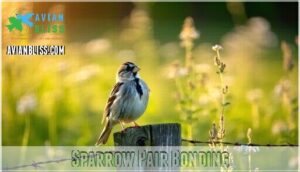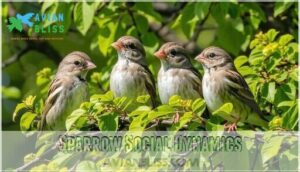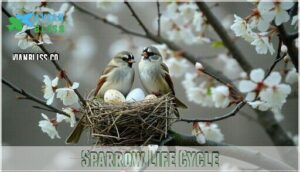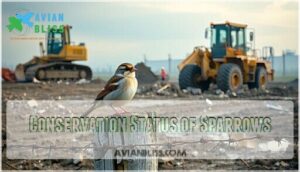This site is supported by our readers. We may earn a commission, at no cost to you, if you purchase through links.

These small songbirds are mostly monogamous, pairing up with one mate to build a nest and raise their chicks.
However, life isn’t always a fairytale—if a mate is lost or another opportunity arises, a sparrow might switch partners.
They’re practical like that, and House sparrows, in particular, form strong bonds but don’t cling too tightly to “happily ever after.”
Think of them as dedicated team players, focused on survival and raising their young, with more to their family dynamics than meets the eye—care to find out?
Table Of Contents
- Key Takeaways
- Sparrow Mating Habits
- Are Sparrows Monogamous?
- Sparrow Nesting Habits
- Sparrow Pair Bonding
- Consequences of Mate Loss
- Sparrow Social Dynamics
- Impact of Human Activity on Sparrows
- Sparrow Behavior and Intelligence
- Sparrow Life Cycle
- Conservation Status of Sparrows
- Are Sparrows an Endangered Species?
- What Are Some Threats to Sparrow Populations?
- How Can Humans Help Conserve Sparrow Populations?
- Do House Sparrows Mate for Life?
- How Long Do Sparrows Live Together?
- How Do Sparrows Mate?
- Are House Sparrows a Good Breeder?
- Do House Sparrows Feed Their Young?
- Are House Sparrows Common?
- What Does a House Sparrow Nest Look Like?
- What Do House Sparrows Eat?
- Why Are House Sparrows a Bad Bird?
- Frequently Asked Questions (FAQs)
- Do house sparrows mate for life?
- How long do sparrows live together?
- How do sparrows mate?
- Are house sparrows a good breeder?
- Do house sparrows feed their young?
- Do house sparrows have a lifelong bond?
- Do House Sparrows Mate for Life?
- What Does a House Sparrow Nest Look Like?
- What do House Sparrows Eat?
- Why Are House Sparrows a Bad Bird?
- Conclusion
Key Takeaways
- Sparrows are mostly monogamous, sticking with one mate during a breeding season or for life, but about 15% engage in extra-pair mating.
- If a mate dies or disappears, sparrows quickly find a replacement, often within a few days during breeding season.
- Long-term pair bonds depend on breeding success, with higher success leading to stronger commitments.
- Sparrows adapt well to environmental challenges, balancing loyalty and practicality to ensure survival.
Sparrow Mating Habits
You’ll find that most house sparrows form seasonal bonds rather than lifelong partnerships, with pairs staying together primarily during breeding periods that typically run from January through July.
During courtship, you’ll notice males attracting females through dramatic displays of plumage and energetic chirps, behaviors that highlight these birds’ complex social dynamics in both urban and natural settings.
What is The Mating Season for Sparrows?
I’ll create an improved, engaging content about sparrow mating seasons.
For sparrows, the mating season kicks off in the depths of winter around January and continues through the warmth of July. These tiny birds don’t waste time in matters of romance!
Sparrows dive into romance as early as January, spreading love across the seasons until July’s warm embrace.
- Males begin their courtship displays as daylight hours increase in late winter
- Breeding activity peaks during spring when insects become abundant for feeding young
- Nesting periods typically start in February and can continue through summer
- Clutch frequency varies, with pairs producing 2-4 broods annually in ideal conditions
- Regional differences exist, with southern sparrows starting earlier than northern populations
You’ll notice these feathered romantics engaging in elaborate rituals throughout this extended period, with males protecting potential nesting sites through persistent chirping. This prolonged sparrow breeding season maximizes their reproductive success, giving them multiple chances to raise young.
How Do Sparrows Choose Their Mates?
After mating season begins, sparrows engage in elaborate courtship rituals.
Male sparrows perform impressive plumage displays, puffing their chest feathers and flicking their wings to attract attention.
They’ll chirp their hearts out near potential nesting sites while carrying nesting material to demonstrate provider skills.
You’ll notice males hopping energetically, showcasing "starter nests" and fiercely guarding territories.
Females exercise female choice, evaluating each suitor’s strength and resourcefulness before pair bonding.
It’s like speed dating with feathers—but the ladies always have the final say!
Do Sparrows Form Long-Term Monogamous Relationships?
Having chosen a mate, sparrows develop fascinating long-term partnerships. While these birds form mostly monogamous relationships, their fidelity isn’t absolute.
- Sparrows typically bond with one partner for multiple breeding seasons, enjoying monogamy benefits like improved parenting skills
- Extra-pair mating does occur—females sometimes seek better genetic matches outside their primary relationship
- When mate loss happens, sparrows demonstrate remarkable adaptability with quick mate replacement, often within days
Breeding success substantially strengthens these bonds. Some species, like the Scarlet Macaw, exhibit long-term monogamy. Studies show that 92% of successful pairs stay together for subsequent seasons, compared to only 63% of unsuccessful ones. These sparrow mating habits showcase how lifelong bonds develop through successful collaboration.
Are Sparrows Monogamous?
You’ll find that house sparrows generally form monogamous pairs for a breeding season rather than for life, though they’ll stay with their partner unless one dies or disappears.
While most sparrows remain loyal to their chosen mate, about 15% engage in extra-pair mating, showing that their version of monogamy includes some flexibility.
Definition of Monogamy in Birds
As we shift our focus from sparrow mating habits, let’s clarify what avian monogamy actually means.
When you hear "birds mate for life," the reality is more complex than you might think.
Bird monogamy comes in several forms.
Social monogamy involves pairs raising young together while occasionally having "flings" elsewhere.
Genetic monogamy means complete fidelity—much rarer in the bird world.
Serial monogamy involves changing partners between breeding seasons.
Research shows about 15% of house sparrows result from extra-pair copulations—nature’s version of "stepping out."
Many birds aren’t loyal to each other as much as to prime nesting territories.
Most monogamous birds are practical rather than romantic.
They’ve evolved this behavior because sharing parental duties boosts their offspring’s survival chances.
It’s less about love and more about successful reproduction.
Examples of Monogamous Bird Species
Across the blue canvas of our skies, monogamous bird species form some of nature’s most enduring partnerships.
When you observe these feathered romantics, you’ll discover fascinating commitment patterns that rival human relationships.
The avian world showcases remarkable examples of monogamy:
- Bald Eagles demonstrate devotion through their spectacular Cartwheel Display, locking talons mid-flight while forming bonds that last decades
- Laysan Albatross pairs remain faithful for up to 70 years, with individuals mourning 1-2 years before seeking new mates
- Black Vulture couples maintain lifelong bonds, staying together year-round rather than just during breeding season
- Mute Swans exemplify commitment with divorce rates under 3% among successful breeders
These winged partnerships vary in intensity and duration. Some species, like the Scarlet Macaw, strengthen their bonds through elaborate preening rituals. Others demonstrate remarkable loyalty through synchronized behaviors developed over years together.
Bird monogamy exists across a fascinating spectrum—from casual seasonal pairings to till-death-do-us-part devotion.
Do Sparrows Fit The Definition of Monogamy?
When examining sparrows through the lens of monogamy, you’ll find they don’t fit neatly into one category.
Most sparrows practice "social monogamy" – they raise young together but aren’t necessarily sexually exclusive.
Studies reveal that up to 90% of bird species, including sparrows, engage in extra-pair copulations despite forming pair bonds.
Breeding success often determines whether partners reunite each season.
While some sparrows maintain lifelong commitments, others quickly find mate replacements when necessary.
Sparrow Nesting Habits
You’ll find sparrows busily crafting spherical nests from sticks, grass, and feathers, typically 8-10 inches in diameter near human habitation.
These resourceful birds use their nests year-round, both for raising young in spring and summer and for resting during fall and winter months, which makes their nests a year-round essential part of their lives.
What Does a Sparrow Nest Look Like?
Moving from sparrows’ monogamous tendencies, let’s examine their remarkable homes.
Sparrow nests are architectural marvels that showcase their natural building skills.
A typical house sparrow nest is spherical and measures 8-10 inches in diameter.
These cozy dwellings feature distinct layers that serve specific purposes:
- Outer shell: Composed of coarse materials like twigs, straw, and even scraps of paper
- Middle section: Made of finer plant fibers for structural integrity
- Inner chamber: Lined with soft feathers and fine grasses for comfort
Both male and female sparrows participate in nest construction, with peak building activity occurring from February through May.
They often utilize specific nesting products to enhance their nests.
While they might look somewhat messy from the outside, these nests are surprisingly sturdy and well-insulated.
Sparrows don’t just use their nests during breeding season—they’re year-round homes for resting and shelter.
Where Do Sparrows Build Their Nests?
While we’ve seen what sparrow nests look like, you might wonder where these resourceful birds choose to build their homes.
House sparrows are masters of nest site selection, favoring locations 8-30 feet above ground that offer protection from predators. Their sparrow nesting preferences include natural cavities in trees, abandoned woodpecker holes, and various nooks in buildings.
What’s fascinating about sparrow nesting behavior is their remarkable urban nesting adaptations. They’ve become experts at utilizing man-made structures, tucking their homes under eaves, inside street lamps, behind loose siding, and even in hanging planters.
To encourage nesting, consider purchasing pre-made sparrow boxes. Sparrows face significant nesting competition, yet their flexibility with nesting materials helps them thrive.
They’ll gather whatever’s available—straw, twigs, paper scraps, feathers, and grasses—to construct their homes. These sparrow nesting sites reflect their practical nature: always close to food sources while maintaining safety from threats.
Do Sparrows Reuse Their Nests?
House sparrows are resourceful nest recyclers in their family life cycle. Unlike many birds, they don’t start from scratch each breeding season.
Here’s how sparrows handle their homes:
- They practice nest renovation, revitalizing old structures with new nest materials instead of complete rebuilds.
- They maintain basic nest sanitation, though not enough to prevent parasite infestation in repeatedly used nests.
- They value nest longevity, with some structures lasting several years through continuous reuse.
You’ll notice sparrow pair bonding strengthens as they return to familiar nesting sites. This practical approach to sparrow nesting habits helps these birds conserve energy for raising multiple broods each year.
Sparrow Pair Bonding
You’ll find that most sparrows form strong, monogamous bonds that typically last for one breeding season rather than their entire lives.
When a sparrow loses its mate, it doesn’t spend much time grieving and will quickly find a replacement, often within just three days.
How Do Sparrows Form Pair Bonds?
The dance of pair bonding begins with sparrow courtship displays that would impress any matchmaker.
Males captivate potential partners through elaborate performances—fluffing feathers, chirping melodiously, and showcasing their nest site selection skills.
These feathered romantics even present food gifts to demonstrate their provider abilities.
Sparrow pair bonding forms quickly but strengthens through shared activities like nest maintenance and territory defense.
While sparrow monogamy is the norm, these relationships depend heavily on breeding success and habitat quality.
Don’t be fooled by their apparent devotion—bird mating behavior isn’t always exclusive.
Colony socialization introduces opportunities for extra-pair copulations, with some sparrows engaging in what we might call "affairs" despite mate guarding efforts.
Do Sparrows Stay With Their Mates for Life?
Despite popular belief, sparrows don’t always stay with the same partner forever. Their commitment depends on several factors, with breeding success playing a pivotal role in whether pairs reunite.
Sparrow relationships are characterized by:
- Moderate monogamy, with 20-40% maintaining bonds across breeding seasons
- Divorce rates varying substantially (a New York study found only 47% of males kept the same partner)
- Extra-pair mating occurring in about 15% of cases
- Rapid mate replacement, often within three days after losing a partner
While sparrows don’t practice perfect lifelong commitment, their bird mating behavior shows they value stable partnerships, especially when they’ve successfully raised chicks together. This pattern of sparrow monogamy reflects their practical approach to survival.
Consequences of Mate Loss
You’ll find that sparrows don’t waste time grieving when they lose a mate, typically finding a replacement within just three days during breeding season.
While they form monogamous bonds that can last a lifetime, their practical nature guarantees they quickly secure new partners to continue their reproductive success.
What Happens When a Sparrow Loses Its Mate?
Four key survival instincts kick in when a sparrow loses its mate. Unlike other birds that mate for life, sparrows prioritize practicality over grief in their mating habits.
The sparrow life cycle doesn’t pause for mourning. You’ll notice this practical approach to remating success guarantees minimal disruption in the sparrow family life, keeping their reproductive efforts on track with remarkable efficiency.
- Replacement speed is remarkably fast—finding new partners within just three days during breeding season
- Males display unwavering loyalty to their nesting sites rather than to partners
- Colony living creates a built-in dating pool, with unmated "helpers" often serving as replacement mates
- Both sexes immediately focus on breeding continuity to maintain offspring survival
The decline in sparrow populations may be linked to fewer nesting sites, which affects their ability to maintain reproductive efforts and ensure offspring survival.
How Do Sparrows React to Mate Loss?
When a sparrow loses its mate, behavioral changes become immediately apparent.
Some withdraw quietly, while others display increased activity and vocalization as they process their loss.
Unlike birds with elaborate grief periods, sparrows typically experience shorter distress phases.
Their grief response involves decreased appetite, increased chirping, and occasional self-isolation from the colony impact.
The sparrow life cycle accommodates loss through adaptive remating behavior – an essential survival trait in their family life.
Replacement speed varies seasonally, with faster pairing during breeding months.
Parental care responsibilities shift temporarily during this adjustment period.
While many wonder "do birds mate for life," sparrows demonstrate how bird mating habits balance emotional connections with practical survival needs, showcasing emotional connections and practical survival needs.
Do Sparrows Find New Mates After Mate Loss?
While grieving doesn’t last long for these practical birds, sparrows quickly find new mates after losing a partner. In fact, these resilient creatures typically remate within just three days during breeding season.
Their Remating Speed depends on several fascinating factors:
- Unattached "helper" birds within the Colony Dynamics often become replacement partners
- Males seeking new mates often showcase better territories to attract higher Mate Quality
- Females typically remate faster than males, prioritizing breeding opportunities
- Helper Impact substantially increases Replacement Success rates
This quick shift guarantees sparrows continue their reproductive cycle without interruption. Though these new partnerships rarely match the stability of original pairings, they’re incredibly effective for survival and continuing their genetic legacy.
Sparrow Social Dynamics
You’ll notice sparrows don’t just pair up for breeding but live in tight-knit colonies of 10-20 birds where everyone knows each other and often works together.
Within these social groups, you’ll find established pairs alongside helper birds who assist mated couples, increasing their own chances of finding a partner if one becomes available.
Do Sparrows Live in Flocks?
Yes, sparrows thrive in organized flocks. These sociable birds form tight-knit colonies of 10-20 individuals, creating stable social structures where members recognize and support each other.
Within these communities, "helper birds" often support mated pairs—improving their own chances of finding a partner if a mate is lost.
| Colony Aspect | Description | Impact on Birds |
|---|---|---|
| Social Stability | Members know each other well | Provides security |
| Helper Birds | Unattached individuals assist pairs | Increases survival |
| Group Activities | Feeding, bathing, roosting together | Strengthens bonds |
What is The Role of Dominance in Sparrow Flocks?
While flocks appear chaotic, sparrow society operates within a strict flock hierarchy.
Dominance in sparrow groups shifts seasonally:
- Females take charge during breeding season
- Males dominate during fall and winter months
- Birds with higher rank get first access to food and nesting sites
- Dominant sparrows often synchronize group activities in larger flocks
This resource control creates social stability as each bird learns its place through observation. You’ll notice territorial behavior when watching feeders, where dominant birds chase others away.
This pecking order directly impacts breeding access, with higher-ranked males displaying their status through distinctive dominance signals like chest puffing and wing fluttering. These displays are a form of non-vocal communication.
How Do Sparrows Interact With Each Other?
Watch a flock of sparrows closely and you’ll peek into a bustling social world that’s anything but random.
These birds interact through a complex set of behaviors within their colony hierarchy.
Sparrows communicate and establish relationships through:
- Colony Hierarchy – Birds know their place, with dominant pairs getting first dibs on food and nesting spots
- Helper Birds – Unmated sparrows often assist bonded pairs with feeding young, improving their own future mating prospects
- Social Stability – Regular preening sessions strengthen bonds between colony members
- Mate Guarding – Males vigilantly protect their partners from extra-pair mating attempts
While some sparrows engage in brief dalliances, many exhibit patterns consistent with mating for life, maintaining their pair bonds even amid the busy social dynamics of their flock.
Impact of Human Activity on Sparrows
You’ll find sparrows adapting to human structures for nesting, often triggering automatic doors at shopping malls to search for food scraps.
Your everyday activities, from urban development to leaving crumbs at a park bench, directly impact these resourceful birds’ mating patterns and colony stability.
How Do Humans Affect Sparrow Populations?
Sparrows face big challenges because of how humans change the world around them.
Modern urbanization redesigns landscapes, replacing cozy old buildings and green spaces with concrete jungles.
These changes shrink sparrow habitats, leaving fewer safe spots to nest and raise young.
That tweet you hear? It’s becoming rarer.
Pollution impacts their health too.
Air from cars and factories interferes with breeding, while bright city lights throw off their natural cycles.
Even pesticides in gardens harm sparrows by wiping out their food sources.
The introduced species we bring into cities, like other birds or predators, create even more competition.
Add climate change into the mix, affecting food availability and nesting resources, and sparrows are left struggling.
Protecting sparrow populations starts with rethinking how cities and neighborhoods support biodiversity.
Small changes can help extend the lifespan of sparrows and preserve chirpy mornings.
What Are The Consequences of Habitat Destruction on Sparrows?
When bird habitats shrink due to urban sprawl, sparrows face major setbacks.
Without safe nesting sites, like tree hollows or cozy roof eaves, sparrows struggle to raise young, leading to fewer chirps in spring.
Habitat loss also means food source decline—pesticides wipe out insects essential for feeding hatchlings.
Population fragmentation adds to the problem, making survival tougher as sparrows spread too thin across disrupted landscapes.
Reduced breeding and increased predation from fewer hiding spots further strain sparrow habitat needs.
It’s a tough battle for these resilient, yet fragile, birds amidst ongoing environmental changes.
Can Humans Help Support Sparrow Populations?
Urban habitats can be tough for sparrows, but you can lend a hand.
These common backyard birds thrive with simple changes. Here’s how you can make a big difference:
- Plant native greenery to provide food and a safe haven.
- Install birdhouses or nesting boxes to offer nesting assistance during the sparrow breeding season.
- Keep a bird feeder and fresh water handy—perfect for attracting sparrows.
- Skip chemicals! Let sparrows act as natural pest controllers, reducing pesticides.
- Join conservation efforts to monitor sparrow conservation status and support long-term well-being.
Consider purchasing products for sparrows to further support their habitat.
These steps help sparrows bounce back while keeping your garden lively.
Sparrow Behavior and Intelligence
You mightn’t think of sparrows as brainy, but they show surprising intelligence in their habits and problem-solving skills.
From building nests in tricky spots to recognizing patterns in human behavior, these birds are smarter than they seem, demonstrating surprising abilities.
How Intelligent Are Sparrows?
If you’ve ever seen a sparrow navigate a busy cityscape, you’ll know they’ve got more than feathers up their sleeves.
These birds demonstrate remarkable problem-solving skills, using spatial awareness to access hidden food or safe nesting spots.
Their ability to adapt is unmatched—they can turn bustling downtowns or quiet farmlands into perfect homes.
Sparrows also thrive on social learning by observing flock mates and mimicking useful behaviors.
Their communication complexity shows through chirps and calls that carry subtle, meaningful messages.
What’s more, their memory is sharp, allowing them to recall food stash locations for months.
Some sparrows even recognize human faces, especially when you’re late refilling bird feeders.
Intelligence in sparrows isn’t just fascinating—it’s linked to adaptability, mating behaviors, and survival in ever-changing environments.
- Problem-solving puzzles for food
- Mimicking flock behaviors
- Switching strategies in cities or farms
- Remembering stash spots for months
- Recognizing humans who maintain feeders
What Are Some Interesting Sparrow Behaviors?
Imagine watching sparrows in action—nature’s tiny multitaskers blending charm and strategy.
Their mating behaviors include chirping serenades, dramatic wing beats, and gift-like nesting materials.
You’ll also notice their incredible Urban Adaptation, thriving in crowded cities by outsmarting predators and mastering Foraging Strategies.
Sparrow Communication is lively, with chirps keeping the flock alert to food or danger.
They even engage in Social Learning, copying clever survival tricks from each other.
These small birds balance predator evasion with forming pair bonds during the breeding season, showcasing adaptability and intelligence in every move.
Some birds will even engage in mobbing as defense to protect themselves from predators.
Do Sparrows Recognize Humans?
Your local sparrows might recall more about you than you’d guess. These little birds are sharper than they seem, showcasing fascinating examples of bird intelligence and human familiarity. Sparrows have an impressive knack for individual recognition, allowing them to remember your face if you’ve fed them—yes, they know who’s who!
Through food association, sparrows build trust, especially if they’ve seen you toss crumbs their way. Their talent for adapting to urban spaces relies heavily on this skill, helping them navigate busy human environments.
- They identify safe humans based on positive interactions.
- Sparrows grow calmer around those they recognize.
- They use keen memories to spot threats or friends.
- Consistent feeding strengthens their sparrow trust and familiarity.
These smarts aren’t just fun bird facts—they prove sparrows thrive through connection!
Sparrow Life Cycle
You’ll find that a sparrow’s life cycle is surprisingly fast-paced, yet full of purpose.
From tiny, speckled eggs to fluttering adults raising their own broods, each stage plays a critical role in their survival.
How Long Do Sparrows Live?
A house sparrow’s lifespan depends on where it lives.
Wild sparrows average 3-5 years but can reach 13. Survival odds are low—only 20% make it past their first year!
Urban sparrows, though, enjoy safer conditions and better food access. Still, weather, predators, and scarcity take their toll.
| Lifespan Factors | Wild | Urban | Captivity |
|---|---|---|---|
| Average Sparrow Age | 3-5 yrs | 4-6 yrs | 10+ yrs |
| First Year Survival Rate | 20% | 40% | 90% |
| Predation Risk | High | Low | None |
| Food Availability | Variable | Steady | Adequate |
What Are The Stages of a Sparrow’s Life Cycle?
Sparrows have a fascinating life cycle, starting with egg development during breeding season. After the hatching process, tiny chicks depend entirely on their parents for warmth and a steady sparrow diet.
They quickly grow into the fledgling stage, a thrilling time of clumsy first flights. Juveniles then strengthen through play and juvenile survival, readying for adulthood.
Molting marks their shift to adult longevity, where sparrow bird facts like "how long do sparrows live" truly come alive. Bird nests, vital for this cycle, often incorporate plant fibers and twigs.
- Key stages to watch: hatching, fledgling, and adulthood.
- **Did you know?
** Fledglings’ first flights are often full of wobbling fun.
- Lifespan trivia: Sparrows typically live 3–5 years, though some reach 7!
What Are Some Threats to Sparrow Survival?
Life can be rough for sparrows, and they face plenty of challenges.
These tiny birds aren’t invincible. Here’s what makes survival tough:
- Habitat Loss: Urbanization forces sparrows into odd spots like gutters or roadside signs—homes far from ideal.
- Pesticide Use and Climate Change: Natural food sources shrink as weather shifts and chemicals harm insects they need.
- Predation: Cats, hawks, and other bird predators pose constant threats.
- Food Competition: Urban sprawl means more birds compete for scraps.
Bird conservation matters—protecting sparrows helps reverse bird decline and fosters thriving ecosystems.
Conservation Status of Sparrows
You mightn’t think twice about sparrows, but their populations are facing challenges worldwide.
Habitat loss, pollution, and competition with other species are just a few threats putting pressure on these familiar birds, with habitat loss being a significant concern.
Are Sparrows an Endangered Species?
It’s hard to imagine sparrows being anything other than everywhere, but their populations are shrinking in many places.
They’re not on the endangered species list, but habitat loss, invasive species, and climate change are making life tougher for them. Urban areas often lack safe nesting spots, and food sources can become scarce. Climate change also disrupts their breeding cycles, creating even more hurdles for these resilient birds.
Fortunately, bird conservation efforts can make a difference.
Here’s how you can help:
- Add nest boxes to your yard or community to provide secure nesting spaces.
- Support green projects that preserve parks and natural areas.
- Learn about sparrow population trends to spread awareness.
- Join bird conservation programs that focus on bird species conservation.
Let’s keep sparrows part of our everyday world!
What Are Some Threats to Sparrow Populations?
For sparrows, the world comes with plenty of challenges these days.
Habitat loss is a big issue; expanding cities and farmland shrink their space to nest and feed.
With pesticide use killing off insects, sparrow parents struggle to find food for their chicks.
Climate change makes things worse, with rising seas and extreme weather ruining nesting sites.
In urban areas, sparrows face daily dangers like window collisions and predation pressure from feral cats.
Competition with invasive species and natural predators, like hawks, adds even more risks.
These external threats all combine to push bird populations into troubling declines.
Conservation efforts are more than just important—they’re essential to ensuring sparrows remain part of our everyday lives and ecosystems.
How Can Humans Help Conserve Sparrow Populations?
Helping sparrows thrive isn’t hard—it’s about thoughtful choices.
Support sparrows by planting native greenery, reducing pesticides, and adding birdhouses—small actions make a big difference!
Add nesting resources like birdhouses to your yard and plant a bird-friendly garden with native plants.
Reducing pesticides protects sparrows and their food supply.
Join bird conservation programs or create community spaces that prioritize bird habitat preservation.
Small steps, like crafting green spaces or supporting bird conservation strategies, go a long way.
Spread community awareness by hosting talks or sharing sparrow facts.
Together, we can revive sparrow populations and enrich local wildlife.
Do House Sparrows Mate for Life?
House sparrows are mostly monogamous birds, forming pair bonds that often last a lifetime.
Still, fidelity isn’t guaranteed—extra-pair mating occurs in about 15% of cases. Divorce rates are low but influenced by breeding success. If a mate is lost, replacement happens quickly.
- Lifelong Commitment: Pairs focus on nesting success.
- Mate Replacement: Happens within days during breeding.
- Fidelity: Guarding reduces extra-pair mating.
How Long Do Sparrows Live Together?
Monogamous birds, like sparrows, often form pair bonds lasting a breeding season or longer.
Some stick to lifelong commitments, though seasonal bonding is typical.
Divorce rates are low, especially in successful bird mating pairs, showcasing impressive bird fidelity and strong pair bond duration despite environmental challenges.
When separation happens, mate replacement occurs quickly, and these adaptable birds guarantee minimal disruption.
How Do Sparrows Mate?
In the context of bird mating systems, sparrows follow fascinating patterns.
Their courtship rituals often include males chirping boldly and flapping wings to woo a mate. Extra-pair copulation occurs occasionally, but mate guarding reduces chances of infidelity.
Once paired, breeding success depends on synchronization and teamwork. These bird mating behaviors highlight the intricate dynamics of mate selection and bonding.
- Highlights of Sparrow Mating:
- Males charm females with energetic chirping.
- Wing displays enhance their appeal.
- Pairs coordinate for successful nesting.
- Mate guarding guarantees loyalty.
- Extra-pair copulation remains relatively rare.
Are House Sparrows a Good Breeder?
In the context of breeding, house sparrows are prolific.
Their breeding frequency allows up to four broods per season, with clutch sizes typically around 5 eggs.
Thanks to excellent parental care and strategic use of nesting resources, fledgling success is high.
Their bird breeding success showcases efficient bird mating behaviors, making house sparrows an impressive example of bird reproduction and adaptable bird mating patterns.
Do House Sparrows Feed Their Young?
Feeding their young showcases house sparrows’ impressive parental investment.
Both parents work tirelessly, bringing a mix of seeds, insects, and grains to nourish dependent fledglings.
Their feeding frequency is remarkable, with visits every few minutes.
- Chick’s menu includes:
- Protein-packed insects to boost growth.
- Soft grains for easy digestion.
- A cooperative breeding effort to guarantee survival.
Are House Sparrows Common?
Sparrows are incredibly common, thriving across their vast habitat range due to their brilliant urban adaptation.
These adaptable birds are an invasive species in many areas, steadily increasing their Sparrow abundance worldwide.
Check their presence below:
| Region | Population Trend | Urban Adaptation | Conservation Status |
|---|---|---|---|
| North America | Increasing | Highly adapted to cities | Not endangered |
| Europe | Stable | Common in both urban and rural | Least concern |
| Asia | Growing | Widespread due to nesting trends | Not threatened |
| Australia | Stable | Introduced, now widespread | Managed invasive species |
The Sparrow abundance is a significant factor in their invasive species status, with a notable presence in various regions, including North America, Europe, Asia, and Australia.
What Does a House Sparrow Nest Look Like?
A sparrow’s nest is a snug 8-10 inch sphere made from twigs, straw, and paper, then lined with soft feathers for warmth.
You’ll find these clever creations tucked into tree cavities, buildings, or birdhouses.
Sparrows are resourceful, often spotting everyday items to serve as bird nesting materials, reflecting their practical bird nesting habits and sharp instincts, which are key to these cozy nests.
What Do House Sparrows Eat?
House Sparrows aren’t picky! Their diet includes seeds, grains, and insects.
Urban environments add crumbs and food scraps from humans to the mix. They’re experts at adapting their foraging behavior to find what’s available, even raiding bird feeders.
This versatile bird diet helps sparrows thrive nearly everywhere, showcasing their resourcefulness and flexibility in both natural and urban settings.
Why Are House Sparrows a Bad Bird?
House sparrows, though small, pack a punch with their aggressive behavior.
They disrupt ecological balance by outcompeting native birds, taking over feeders, and destroying nests.
Their nesting habits become a nuisance in urban spaces, while their introduction has impacted bird populations.
Known for spreading disease and causing crop damage, their territorial nature brands them as fierce competitors in bird communities.
Frequently Asked Questions (FAQs)
Do house sparrows mate for life?
Pairing up with a partner is a big deal for house sparrows.
They’re mostly monogamous, sticking with one mate for life.
But occasional “flings” happen, about 15% of the time, adding a twist to their loyalty.
How long do sparrows live together?
You’ll often see sparrow pairs staying together for a single breeding season, though some form lifelong bonds.
If a partner is lost, they quickly find a new mate, ensuring their nesting efforts continue smoothly.
How do sparrows mate?
Males woo females with dramatic chirps and wing displays, showing off their nesting skills.
Once paired, they mate frequently near the nest.
It’s a mix of persistence and charm that fuels their connection.
Are house sparrows a good breeder?
Imagine sparrows building nests almost anywhere, even in city nooks.
They’re prolific breeders, producing 2-4 broods annually.
Females lay up to 7 eggs, with both parents nurturing their young, making them excellent adaptable breeders.
Do house sparrows feed their young?
House sparrows definitely feed their young!
Both parents pitch in, bringing insects to the nest.
The male keeps up the effort even while the female prepares for the next brood.
Parenting really is a team sport!
Do house sparrows have a lifelong bond?
Lovebirds may get all the credit, but house sparrows form strong seasonal bonds too.
They usually stay loyal to one partner for life, unless something happens.
Still, 15% sneak in “extra dates” now and then, which can be considered as “extra dates”.
Do House Sparrows Mate for Life?
Sparrows form strong pair bonds, usually for life.
They’ll quickly find a new mate during breeding season if one is lost.
While most stay loyal, about 15% of chicks are from extra-pair matings.
What Does a House Sparrow Nest Look Like?
A house sparrow’s nest looks like a messy ball of coarse grasses, straw, and feathers.
These birds cram it into nooks or crannies, creating a cozy yet chaotic spot for laying eggs and raising chicks.
What do House Sparrows Eat?
Seeds, grains, and insects make up most of their diet, but they’ll also snag crumbs or scraps from your picnic.
These opportunistic eaters adapt well, even munching on small fruits or stray bits of food.
Why Are House Sparrows a Bad Bird?
Imagine a charming neighbor who steals your tools, invades your garden, and refuses to leave.
House sparrows harm native birds, outcompete for nesting spots, and even destroy eggs, disrupting ecosystems with their aggressive behavior.
Conclusion
Picture a pair of sparrows building their nest, chirping softly as they work together like a well-practiced team.
While sparrows don’t always mate for life, many remain loyal throughout a breeding season, raising their young with care.
These monogamous birds are practical, adapting to changes and prioritizing survival.
If a mate is lost, sparrows move on and find new partners to guarantee their lineage continues, which showcases their ability to form new bonds and ensure their survival.
So, do sparrows mate for life? Not always, but their bonds are remarkable.












